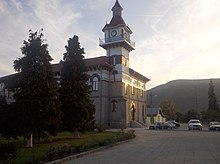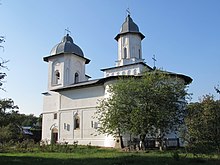Târgu Ocna is a resort city of 11,300 people (2011) in the Bacău County, in Moldavia, Romania. Târgu Ocna is built among the Carpathian Mountains on bare hills formed of rock salt. In fact the English translation of Ocna is salt mine.
Understand
[edit]
Târgu Ocna's main industry is salt production, as it is the largest provider in Moldavia. Other industries include wood processing, coal mining, steel producing, and petroleum-based industries.
Climate
[edit]The city has milder winters than in the surrounding regions (average -1.3 °C), early springs and cool summers due to the mountain breeze (average 19.7 °C) and autumn relatively long, warm and serene. The average annual temperature is 9.3 °C.
Get in
[edit]It is crossed by the national road DN12A, which connects Onești with Miercurea-Ciuc. In Târgu Ocna, from this road branches the national road DN12B, which leads to Slănic-Moldova and also DN12A intersects there with the county road DJ116, which connects it south to Pârgărești and Oituz (where it ends in DN11) and north of Bârsănești (where it also ends in DN11).
The Adjud – Comănești – Siculeni railway also passes through the commune, which is served by the Târgu Ocna station and by the Saline and Cireșoaia passenger stops.
Get around
[edit]See
[edit]
- Târgu Ocna Salt Mine within the Trotuș Mine
- The ensemble of the Saint Nicholas church (Biserica "Sfântul Nicolae", built in 1580, with modifications in 1768 and 1883), with the church, the enclosure wall (built in 1768), and the memorial ensemble 1916–1918 (made in 1932)

- The former Răducanu monastery (17th – 18th centuries), ensemble comprising the “Buna Vestire” church (built in 1664 with modifications in 1762), the entrance tower, the enclosure wall and the ruins of an enclosure construction (all from 1712).
- Archeological site in the Podei district, 500 m southeast of the city, on the right bank of the Sidewalk, where there are traces of the Utidava fortress (La Tène period , Geto-Dacian culture, 1st century BC - 1st century), as well as settlements from the Eneolithic (Cucuteni culture ) and from the Bronze Age (Monteoru culture).
- Monuments of local interest include the “Holy Trinity” church (1809) in the Gura Slănicului neighborhood; Borisof House (1890); the "Holy Dukes" church (18th century, rebuilt in 1849);the ensemble of the “Pious Paraschiva” church, with the wooden church (built in the 17th century and rebuilt in 1725) and the bell tower erected in the 19th century; the church "Saint John the Baptist" (1815); the wooden church "Saint George" (built in 1761 with additions in 1895); and the church "Assumption" - Precista (built in 1683 and rebuilt in 1860). Finally, the bust of Costache Negri (1941) in front of the town hall is classified as a public forum monument.
Do
[edit]- The spa treatment centre in Măgura Park offers medical testing spaces, physiotherapy, maintenance and recovery spaces, and related technical spaces. Physiotherap, electrotherapy, galvanic baths, paraffin wraps, diet therapy, recovery massage, underwater shower, aerosol treatments, beauty cabinet, lymphatic drainage. Two outdoor swimming pools, one for adults and the other for children.
- Seven springs of mineral water appear in the city park, along an alignment, the catchments of which have been arranged and used since 1888 . Analyzes performed by the National Institute of Recovery, Physical Medicine and Balneoclimatology showed that they have mineral contents between 4,139 -12,793 g / I, and are of therapeutic interest for internal and external treatment, being sulfurous, chlorinated, sodium, weak bicarbonate, hypotonic, recommended for the treatment of diseases of the digestive tract, hepato-biliary, chronic gynecological, rheumatic and respiratory tract.
Buy
[edit]Eat
[edit]Drink
[edit]Sleep
[edit]- Hotel Magura, in the city center, 200 m from the train station, has 115 rooms. It is recommended primarily to those who are treated for asthma in the mine sanatorium, as well as to those who travel in the vicinity. It has a recovery-rehabilitation department for human health with a capacity of 100 seats and which offers BFT outpatient medical services and hospitalizations - recovery.

